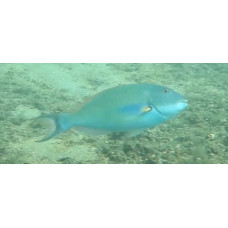Latin name
Scarus taeniopterus
Other names
Scarus taeniopterus
Identification
Known for their beak-shaped jaws that fuse with their teeth. Their individual teeth allow them to crush food. The pharyngeal jaw is a second set of teeth located in the throat. The scales are cycloid in shape with smooth edges.
Features of fish fins
Dorsal spines (total): 9; Dorsal soft rays (total): 10; Anal spines: 3; Anal soft rays: 9.
Fish colouring
The colouration depends on the sex of the fish. Males have a blue body with yellow veins, while females are white with orange and brown shadings.
Distribution
These fish can be found along the north coast of the Great Barrier Reef, the Bahamas and the Caribbean.
Habitat
A marine tropical species. They live on coral or rocky bottoms. They prefer to swim in shallow water where corals grow in bright light, but can also be found among algae. They inhabit depths from 3 to 25 metres (9.8-82.0 feet).
Size
Maximum length: 35.0 cm. Normal length: 22.0 cm.
Behavior
Forms large schools. Swim around reefs and sandy areas during the day, collecting algae on which they feed. Play an important role in the ecosystem, being a key link in the coral reef food chain. Fish scrape the surface and dig into calcareous formations to obtain the nutrients they need. They are known to exert top-down control over algae, and when these fish are overfished in certain habitats, an increase in algal biomass can be observed.
Food and feeding habits
Their diet consists of algae and coral polyps, and they are known to be primarily herbivorous. By eating epilithic algae, the fish can create space for young corals to settle and grow. They play an important role in the recovery of coral reefs after major disturbances. Their strong teeth, fused with beak-like jaws, allow them to pulverise their food.
Reproduction
Egg-laying, clearly mating during reproduction. Spawns throughout the year in low sunlight. Peak spawning usually occurs during the summer season. No evidence of parental behaviour. Eggs are transported by tidal currents and usually hatch one day after fertilisation. They develop rapidly and may take several years to reach maturity. Have a maximum life span of 20 years, but most live 5 years or less. The family is known for its complex reproductive system. Males can be either born male or sex-changed female, depending on the reproductive circumstances they face and whether it is advantageous to be of one sex or the other.
Fishing
Small commercial fishery. Fished for aquarium breeding.
Relationship with a person
There have been reports of ciguatera poisoning.
| Classification | |
| Phylum | Chordata |
| Class | Actinopterygii |
| Squad | Labriformes |
| Family | Scaridae |
| Genus | Scarus |
| Species | S. taeniopterus |
| Features | |
| Conservation status | Least Concern |
| Habitat | Bottom |
| Life span, years | No information |
| Maximum body weight, kg | No information |
| Maximum length, cm | 25 |
| Sailing speed, m/s | No information |
| Threat to people | Edible |
| Way of eating | Planktonophage |
Princess parrotfish
Tags: princess parrotfish



